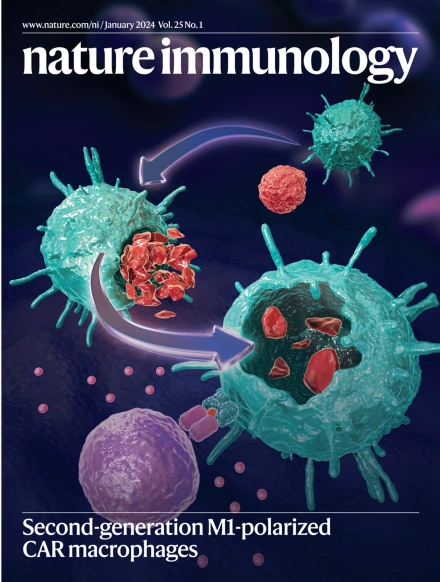不同的1型免疫网络是COVID-19后限制性肺部疾病严重程度的基础
IF 27.7
1区 医学
Q1 IMMUNOLOGY
引用次数: 0
摘要
2019冠状病毒病(COVID-19)后持续呼吸困难的病因不一,阻碍了对肺部后遗症免疫病理学的研究。在这里,我们分析了离散肺表型背景下的数百个细胞和分子特征,以定义covid后肺部疾病的系统免疫景观。肺生理学测量的聚类分析突出了限制性肺病的两种表型,根据其扩散受损和纤维化严重程度不同。机器学习揭示了在轻度肺部疾病中显著的CCR5+CD95+CD8+ T细胞扰动,但在更严重的疾病中,以CXCL13升高为特征的T细胞反应减弱。不同的细胞组、介质和自身抗体区分了每种限制性表型,并且与没有严重肺部受累的患者不同。根据肺部疾病的严重程度,这些差异反映在不同的基于T细胞的1型网络中。我们的研究结果为COVID-19后活动性肺损伤对抗晚期疾病提供了免疫学基础,可能为治疗提供新的靶点。本文章由计算机程序翻译,如有差异,请以英文原文为准。


Distinct type 1 immune networks underlie the severity of restrictive lung disease after COVID-19
The variable origins of persistent breathlessness after coronavirus disease 2019 (COVID-19) have hindered efforts to decipher the immunopathology of lung sequelae. Here we analyzed hundreds of cellular and molecular features in the context of discrete pulmonary phenotypes to define the systemic immune landscape of post-COVID lung disease. Cluster analysis of lung physiology measures highlighted two phenotypes of restrictive lung disease that differed according to their impaired diffusion and severity of fibrosis. Machine learning revealed marked CCR5+CD95+CD8+ T cell perturbations in milder lung disease but attenuated T cell responses hallmarked by elevated CXCL13 in more severe disease. Distinct sets of cells, mediators and autoantibodies distinguished each restrictive phenotype and differed from those of patients without substantial lung involvement. These differences were reflected in divergent T cell-based type 1 networks according to the severity of lung disease. Our findings, which provide an immunological basis for active lung injury versus advanced disease after COVID-19, might offer new targets for treatment. This study presents a comprehensive immunological assessment of post-coronavirus disease (COVID) respiratory illness, finding signatures potentially associated with recovery and candidate biomarkers for more severe lung disease.
求助全文
通过发布文献求助,成功后即可免费获取论文全文。
去求助
来源期刊

Nature Immunology
医学-免疫学
CiteScore
40.00
自引率
2.30%
发文量
248
审稿时长
4-8 weeks
期刊介绍:
Nature Immunology is a monthly journal that publishes the highest quality research in all areas of immunology. The editorial decisions are made by a team of full-time professional editors. The journal prioritizes work that provides translational and/or fundamental insight into the workings of the immune system. It covers a wide range of topics including innate immunity and inflammation, development, immune receptors, signaling and apoptosis, antigen presentation, gene regulation and recombination, cellular and systemic immunity, vaccines, immune tolerance, autoimmunity, tumor immunology, and microbial immunopathology. In addition to publishing significant original research, Nature Immunology also includes comments, News and Views, research highlights, matters arising from readers, and reviews of the literature. The journal serves as a major conduit of top-quality information for the immunology community.
 求助内容:
求助内容: 应助结果提醒方式:
应助结果提醒方式:


